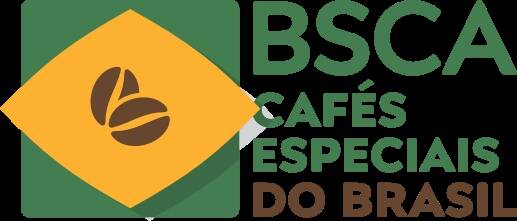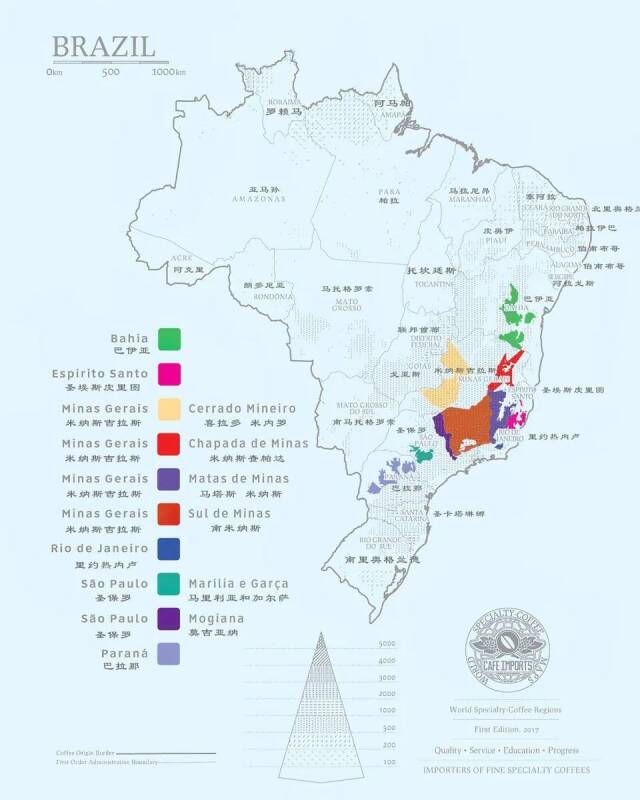Brazil coffee producing area, coffee history, coffee bean species, Brazil queen estate coffee beans introduction
Brazil is the largest country in South America, bordering ten countries, including Uruguay, Peru, Bolivia and Colombia. Brazil has a developed coffee industry. Brazil is the country with the largest coffee production and export volume in the world, accounting for 1/3 of the world's coffee exports.
But coffee is not native to Brazil. In 1727, a sergeant major, Franciso de Mello Palheta, was commissioned to go to French Guinaya, when France restricted the export of coffee beans. In order to succeed, the sergeant major won the trust of the wife of the governor of French Guiana. At the end of the trip, the lady gave him an Arabica coffee seed. And took the seed back to the Brazilian state of Para. As the climate in Brazil is suitable for growing coffee, coffee cultivation quickly extends to other Brazilian states. By 1830, coffee was already Brazil's main export, accounting for 30% of the world's coffee production, which boosted Brazil's economy, especially in the state of Sao Paulo, which built new railways to transport goods to the port of Santos. During the Cold War in 1965, coffee production was seriously overproduced and coffee prices fell sharply. Therefore, Brazil has signed international coffee conventions with a number of countries to restrict exports. The Convention was not introduced until 1989 and the Brazilian Fine Coffee Association (BSCA) was founded in 1991.

There are 26 states in Brazil, of which 17 produce coffee. Among the 17 states, Parana, Sao Paulo, Miraz Gerais and Esp í rito Santo account for 80% of the total output, while Milasquillas has the highest production, accounting for 30% of the total production. Brazil's Arabica accounts for 80% of total production and the remaining 20% is Robusta. Among them, the main planting has been bourbon, Kaduai, iron pickup, New World and so on, and the harvest period is from May to September.

Bahia is considered by many to be the southernmost coffee region in the world. Although the state accounts for only 2.5 per cent of Brazil's area, it produces 25 per cent of its crops. But the state lacks high-altitude areas, with the highest elevation of only 950 meters, so there is little high-quality coffee.
S â o Paulo is home to Mojiana, Brazil's more famous coffee producing area, with rugged terrain and red sandy soil rich in minerals, making it very suitable for growing coffee. In front of the street, the Queen's Manor from Brazil is the producing area of Mojiana, which is a kind of yellow bourbon bean seed, which is treated in half-sun and boiled with V60 meme 1purge 15 to have the sweet, black tea, nut and chocolate flavor of sugarcane, which is bright, smooth and delicate.
The state of Minas Gerais, located in southeastern Brazil, has some of the highest mountains in the country. And the relatively famous producing areas of Syracuse and South Minas are in this state. Many coffee plantations in this state are relatively large in area, so most of them use machinery for farming and harvesting, at an altitude of 700-1350 meters.
The state of Esp í rito Santo (Espirito Santo) has a smaller area compared to other coffee producing areas. Victoria, the capital, says it is the main export port. 80% of the area grows Robusta, and only southern farmers such as this area tend to grow Arabica. It is 90-1200 meters above sea level.
Important Notice :
前街咖啡 FrontStreet Coffee has moved to new addredd:
FrontStreet Coffee Address: 315,Donghua East Road,GuangZhou
Tel:020 38364473
- Prev

The consumer team sued Starbucks' claim for "100% ethical procurement" in coffee producing areas.
Recently, a well-known American consumer rights group, the National Consumer Union (NCL), filed a lawsuit against Starbucks Coffee in the High Court of the District of Columbia, accusing Starbucks of fraudulent claims about ethical coffee procurement, which has been marketing consumers' preferences for ethical coffee products.
- Next

Lucky launched hand-made coffee, netizen: don't play!
▲ Click to follow | Daily boutique Coffee Culture Magazine Coffee Workshop all the time, Luckin Coffee gives consumers the impression that besides various joint names, it is 9.9 a cup of coffee, which also causes the public's positioning of Luckin Coffee to stay on the low-price chain coffee brand, which is less refined and more than Starbucks.
Related
- What effect does Italian American coffee with filter paper have? Will coffee taste better if it is put on filter paper at the bottom of the powder bowl?
- What is the color difference in coffee beans? What are the characteristics of honey processed coffee beans? Why are the anaerobically treated coffee beans uneven in color?
- How does novice Xiaobai quickly get started and make coffee? Newbies learn to make coffee by hand and share the specific steps and process process!
- Costa tea has a shelf life of 100 years?! Expert: Unable to verify
- It's a huge uproar! American milk addition was rejected by Manner employees?!
- Mocha pot coffee bean recommendations| How fine and how much powder should be used for grinding? What parameter ratios do I need to use to make milk with Mocha pot coffee?
- What are the characteristics of the world's top ten coffee beans treated with Costa Rica honey? How to make black honey kadura from Tarazhu Pilon Processing Plant taste good?
- How to make deep-roasted coffee? What grinding water temperature does authentic Jamaica Blue Mountain No. 1 coffee use to brew it well?
- Selected high-grade rose summer coffee flavor tasting guide Why Panama rose summer has the aroma of flowers and fruits
- What equipment does a novice Xiaobai need to buy to learn to make coffee? Filter cup electronic scale bean grinder manual flushing pot purchase guide

